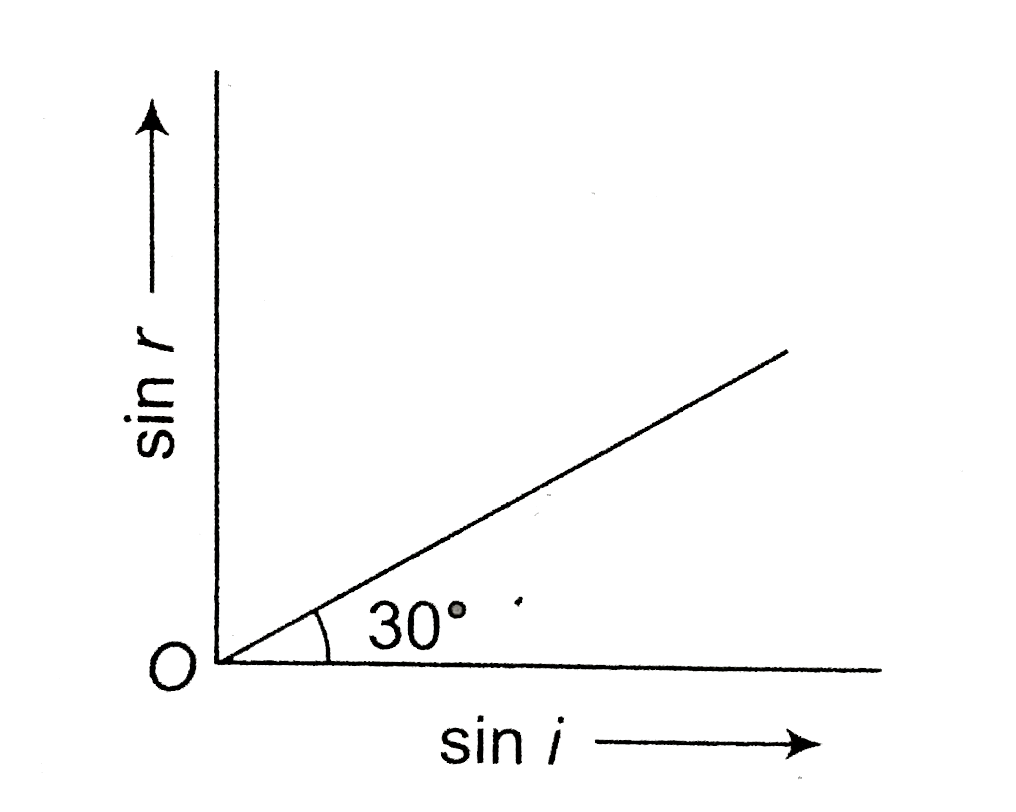The velocity of light in a medium is half its velocity in air. If a ray of light emerges from such a medium into air, the angle of incidenc, at which it will be totally internally reflected, is
15∘
30∘
45∘
60∘
The correct Answer is:B
To solve the problem, we need to determine the angle of incidence at which total internal reflection occurs when light transitions from a medium to air. Here’s a step-by-step solution:
Step 1: Understand the given information
We know that the velocity of light in the medium (Vm) is half of its velocity in air (C). Therefore, we can express this as:
Vm=C2
Step 2: Calculate the refractive index (μ)
The refractive index (μ) of a medium is defined as the ratio of the speed of light in air (or vacuum) to the speed of light in the medium:
μ=CVm
Substituting the value of Vm:
μ=CC2=2
Step 3: Determine the critical angle (C)
Total internal reflection occurs when the angle of incidence exceeds the critical angle (C). The critical angle can be found using the formula:
sinC=1μ
Substituting the value of μ:
sinC=12
Step 4: Calculate the critical angle
Now, we can find the critical angle by taking the inverse sine:
C=sin−1(12)
This gives us:
C=30∘
Step 5: Conclusion
For total internal reflection to occur, the angle of incidence must be greater than the critical angle. Therefore, the angle of incidence at which total internal reflection will start is:
Angle of incidence>30∘
Final Answer
The angle of incidence at which total internal reflection occurs is greater than 30 degrees.
---
We know that the velocity of light in the medium (Vm) is half of its velocity in air (C). Therefore, we can express this as:
Vm=C2
The refractive index (μ) of a medium is defined as the ratio of the speed of light in air (or vacuum) to the speed of light in the medium:
μ=CVm
Substituting the value of Vm:
μ=CC2=2
Total internal reflection occurs when the angle of incidence exceeds the critical angle (C). The critical angle can be found using the formula:
sinC=1μ
Substituting the value of μ:
sinC=12
Now, we can find the critical angle by taking the inverse sine:
C=sin−1(12)
This gives us:
C=30∘
For total internal reflection to occur, the angle of incidence must be greater than the critical angle. Therefore, the angle of incidence at which total internal reflection will start is:
Angle of incidence>30∘
The angle of incidence at which total internal reflection occurs is greater than 30 degrees.
Topper's Solved these Questions
- GEOMETRICAL OPTICSBOOK - CENGAGE PHYSICS ENGLISHCHAPTER - GEOMETRICAL OPTICSEXERCISE - Assertion-Reasoninig
2 Videos
- GEOMETRICAL OPTICSBOOK - CENGAGE PHYSICS ENGLISHCHAPTER - GEOMETRICAL OPTICSEXERCISE - Linked Comprehension
51 Videos
- GEOMETRICAL OPTICSBOOK - CENGAGE PHYSICS ENGLISHCHAPTER - GEOMETRICAL OPTICSEXERCISE - Subjective
26 Videos
- ELECTRON,PHONTS,PHOTOELECTRIC EFFECT & X-RAYSBOOK - CENGAGE PHYSICS ENGLISHCHAPTER - ELECTRON,PHONTS,PHOTOELECTRIC EFFECT & X-RAYSEXERCISE - dpp 3.3
15 Videos
- HEATING EFFECT OF CURRENTBOOK - CENGAGE PHYSICS ENGLISHCHAPTER - HEATING EFFECT OF CURRENTEXERCISE - Thermal Power in Resistance Connected in Circuit
27 Videos
Similar Questions
Ray of light bends as light travels from one medium to another.
View SolutionWhen light is incident on a medium at angle i and refracted into a second medium at an angle r, the graph of sinr versus sini is as shown. From this one can conclude that

(i) the velocity of light in second medium is √3 times the velocity of light in the first medium
(ii) the velocity of light in the first medium is √3 times the velocity of ligth in second medium
(iii) the critical angle of the two media is given by siniC=1√3
(iv) the critical anlge of the two media is given by siniC=1√2
View Solution
Knowledge Check
When a ray of light from air enters a denser medium, it :
Abends away from the normalBbends towards the normalCgoes undeviatedDis reflected backWhen a light ray enters from a denser medium to a rarer medium.
AThe light ray bends towards the normal.BAngle of incidence is less than angle of refraction.CSpeed of light decreases.DSpeed of light remains unchanged.
A ray of light passes from vaccum into a medium of refractive index n. If the angle of incidence is twice the angle of refraction, then the angle of incidence is
View SolutionIf c is velocity of light in vacuum and v is the velocity of light in a medium of refractive index μ, then
View SolutionA ray of light is incident on a medium boundry at polarising angle such that its deviation is 24∘, then angle of incidence is :
View SolutionA ray of light travelling in a transparent medium falls on a surface separating the medium from air at an angle of incidence of 45∘. The ray undergoes total internal reflection. If n is the refractive index of the medium with respect to air, select the possible value of n from the following.
View SolutionThe critical angle between a certain transparent medium and air is ϕ. A ray of light travelling through air enters the medium at an angle of incidence equal to its Brewster angle θ. Therefore, the angle of refraction is
View SolutionThe critical angle between a certain transparent medium and air is ϕ. A ray of light travelling through air enters the medium at an angle of incidence equal to its Brewster angle θ. Therefore, the angle of refraction is
View Solution
